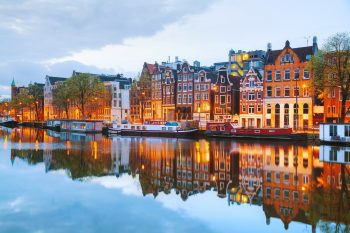Energy Cities says it is time to turn up the heat on Member States for failing on local heating and cooling planning
Celebrating the first anniversary of the publication of the EED, Energy Cities is taking stock of the local heating and cooling planning transposition.
The new Energy Efficiency Directive (EED) requires Member States to ensure that municipalities with over 45 000 inhabitants prepare local heating and cooling plans. This proposition can be a GAME CHANGER to decarbonise the heating and cooling sector, and provide citizens with healthier and more resilient living environments.
According to Energy Cities’ latest analysis, Member States are not on track to meet the objectives of the EED and are running late transposing article 25.6 on local heating and cooling plans.
- 4 member states have set the appropriate legal framework to be compliant with article 25.6 of the EED. The Netherlands, Germany, Denmark, Lithuania.
- 1 Member state has officially transposed article 25.6 : Germany.
- 13 Member states are seriously lagging behind with regards to the appropriate legal framework.
- 2 Member State (NL, DK) have set the appropriate support framework, being financial, technical and staff resources
Member States must speed up and set up support for municipalities while the EU institutions should provide better support. In an open-letter addressed to the new Energy Commissioner (Dan Jørgensen), Mohamed Ridouani, Mayor of Leuven and President of Energy Cities, said:
“EU support for cities’ energy transition will be crucial. The Covenant of Mayors’ movement has proven to be a successful partnership between cities and the EU institutions. We can do more to mobilise municipalities across the EU and bring every community into the transition. Massively increasing local renewable energy production is an important first step, but it is pivotal to increase local capacities to decarbonise Heating and Cooling if we are to meet all of our challenges ».
Find out the latest state of play on our EU tracker.
The good, the bad and the ugly
Energy Cities analysed the legislative frameworks and support mechanisms available to local authorities for planning the decarbonisation of heating and cooling across the 27 EU countries. There is a widespread lack of appropriate legislative frameworks and effective support mechanisms for local governments. In most countries, local authorities are left in the blue with low technical assistance or insufficient financial support. In Austria, technical and organisational support for local energy planning remains fragmented in terms of content and geography and is often project based. France has set up an innovative structure to help with heat projects through the “Heat Fund”, however there is no dedicated support to finance staff of local authorities for heat or energy planning.
However, Energy Cities also identified best practices that Member States should consider when legislating for local planning of heating and cooling decarbonization, especially in the context of transposing Article 25.6 of the Energy Efficiency Directive.
Good practices can be drawn from Germany and The Netherlands.

Germany is the first Member State to transpose the directive. The transposition includes key elements such as varying timelines based on population size (above or below 100,000 inhabitants), and a three-step approach for drafting local heating and cooling plans (inventory analysis, renewable potential mapping, and future heat project scenarios). Despite the improved legal framework, challenges remain, including a shortage of skilled workers, particularly in planning, and limited financial resources for smaller communities. Germany will need to enhance the supportive framework to help municipalities achieve their objectives. In general, we see that technical and financial support is key for the successful implementation of the directive. This will be a challenge in most Member States.
Read our article for more information.

The Netherlands has set up an efficient multi-level governance structure. Strong coordination between the national, regional and local decarbonisation strategies, via multi-level dialogue and various working groups. According to the Dutch Climate Agreement, the municipal vision on heat transition shall comply with regional energy strategy. Moreover, municipalities engaged in the “Out of Gas program” receive national funds to finance job positions to perform heat planning.
Read our article for more information.
Southern countries are behind and other are catching up
Italy submitted its updated NECP with lower ambition for renewable energy and energy efficiency. Italy will not meet its renewable heating and cooling objectives without a supportive legal framework. Large efforts remain necessary in Italy to ensure that local governments can access sufficiently granular and comprehensive needed for the drafting of heating and cooling assessments and plans. The quality and type of data municipalities can access varies across Italian regions. Energy supply data are usually available as utilities are obliged to share their data, however often not in a harmonised format which brings additional costs for usage.
Spain is not ready for implementing EED article 25.6, which will require regulatory changes, improved coordination and strengthened support mechanisms. The draft update of the NECP, submitted in 2023, includes a measure (2.10) on local heating and cooling planning to comply with new EED requirements for local heating and cooling plans (article 25). However, it does not establish targets for timing or scope. The final NECP has not been submitted on time.
France published its updated NECP in July 2024. The new NECP plans for the drafting of local heating and cooling plans. However, there is no mention of the level of support for municipalities. French local authorities benefit from a facilitated access to energy data, especially regarding electricity, gas, heating and cooling, and fuels consumption. Despite a relatively good support framework for energy and climate local policies, there is no dedicated national programme to phase out fossil fuels in the heating sector and to support consistent strategic heating and cooling planning at local level.
Policy recommendations
Member States have one more year to transpose the EED. To ensure a sufficiently ambitious approach and based on best practices, Energy Cities recommends the 8 following features :
- Threshold Definition – Developing a local plan is mandatory for municipalities with more than 45,000 inhabitants. However, it is recommended to adopt a relatively lower threshold (e.g., for municipalities with more than 20,000 inhabitants) to equip a larger portion of the national territory with local plans. Secondly, we advise maintaining support for municipalities voluntarily engaged in heat and cold planning and providing appropriate resources based on the capacities of small, medium, and large municipalities. The threshold should be adapted to the national and regional context.
- Announced Timeline – The directive does not specify a timeline for adopting local plans; however, they must contribute to achieving the 2030, 2040, and 2050 goals. Therefore, they must be adopted well before 2030. The national transposition must incorporate a precise timeline for the adoption of local plans. This timeline can be adjusted based on several criteria: municipality size, existing obligations, etc.
- Synergies with Existing Plans – To avoid additional administrative burden on municipalities, it is strongly advised that these plans be tied to existing planning obligations (energy and climate plans, local urban plans, etc.), while simultaneously enhancing ambition and specifically addressing heat and cold uses (production, consumption, transport, and distribution). This could be reflected in a population threshold for obligated municipalities and an implementation schedule aligned with existing plans.
- Collected and Centralized Data – The transposition of the directive must facilitate the collection and availability of energy data for local authorities. Data availability is essential for establishing diagnostics and constructing decarbonization scenarios for heat and cold uses. For example, this could involve the creation of a common centralized platform providing essential datasets (energy consumption, building stock, infrastructure, renewable energy production potential, etc.).
- Structured Methodology – Article 25.6 sets minimum conditions for developing local plans; however, the directive does not provide a complete methodological framework or model. To ensure sufficient plan quality, data harmonization, and effective management, a common methodology for various municipalities should be provided. This could take the form of a multi-step approach framed by selection criteria: defining ambition and mobilizing stakeholders, analyzing the current situation, assessing decarbonization potential, constructing scenarios, their adoption and implementation, and evaluation. The methodology could also encourage neighborhood-scale planning. This methodology should also frame stakeholder involvement.
- Strategic and Spatial Planning – The transposition of Article 25.6 should enable local authorities to develop strategic and spatial decarbonization plans for various heat and cold uses, incorporating the geographic and economic specificities of their territories, building stocks, and taking into account all energy vectors (electricity, heat, cold, gas). The transposition should not be limited to planning centered around one or more technologies (district heating, geothermal energy, etc.).
- Co-construction with Stakeholders – The adoption and implementation of local plans require the involvement of numerous actors to achieve climate neutrality. Beyond consultation, the transposition must provide for the co-construction of local plans with local and regional energy, housing, urban planning, industry, and tertiary sector actors, as well as citizens and consumers. For example, this could involve engaging residents in energy projects by developing the legal framework for the creation of energy communities for renewable heat, or aligning local heat and cold planning with the planning of energy operators.
- Technical and Financial Support – The directive stipulates that Member States should support local and regional authorities in planning and decarbonizing heat and cold. Without this support, there is a high risk that this new obligation for local authorities will be merely an administrative exercise with no real impact on reducing greenhouse gas emissions. Member States should create national competence centers to guide local authorities and establish financial mechanisms to support both the planning requirement and the implementation of actions in these local plans.
In addition to transposing Article 25.6, national measures to promote renewable energy and phase out fossil fuels are necessary. This could include banning the installation and eventual use of heating appliances powered by oil, natural gas, and coal. Furthermore, planning the gradual phase-out of natural gas and ensuring the success of deploying renewable energy vectors is essential.
Find out the latest state of play on our EU tracker.
If you are not yet one of our valued members, join us!

